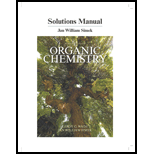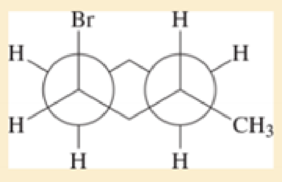
Student's Solutions Manual for Organic Chemistry
9th Edition
ISBN: 9780134160375
Author: Leroy G. Wade, Jan W. Simek
Publisher: PEARSON
expand_more
expand_more
format_list_bulleted
Concept explainers
Textbook Question
Chapter 3, Problem 3.52SP
This is a Newman projection of a substituted cyclohexane.
- a. Draw the equivalent chair form.
- b. Draw the equivalent structure using wedge and dash notation on a cyclohexane hexagon.
- c. Give the IUPAC name.

Expert Solution & Answer
Want to see the full answer?
Check out a sample textbook solution
Students have asked these similar questions
Reason whether it is possible to determine changes in the Galvani potential difference at the metal-solution interface.
Obtain the standard potential at 25°C of the Cu* I Cu | Pt electrode
from the standard potentials E°
Cu²+/Cu
= 0.341 V and E
Cu²+ /Cu+
= 0.153 V.
In electrochemistry, briefly describe the Galvani potential, the Volta potential, and the surface potential. Differentiate between them.
Chapter 3 Solutions
Student's Solutions Manual for Organic Chemistry
Ch. 3.2 - Using the general molecular formula for alkanes:...Ch. 3.3B - Name the following alkanes and haloalkanes. When...Ch. 3.3B - Write structures for the following compounds. a....Ch. 3.3B - Provide IUPAC names for the following compounds....Ch. 3.3B - Prob. 3.5PCh. 3.3B - Prob. 3.6PCh. 3.3B - Prob. 3.7PCh. 3.3B - Draw the structures of the following compounds. a....Ch. 3.3B - Without looking at the structures, give molecular...Ch. 3.4C - Prob. 3.10P
Ch. 3.7B - Prob. 3.11PCh. 3.7C - Draw a graph similar to Figure 3-9, of the...Ch. 3.8B - Draw a graph similar to Figure 3-11, of the...Ch. 3.9 - Draw a perspective representation of the most...Ch. 3.10C - Give IUPAC names for the following compounds.Ch. 3.10C - Draw the structure and give the molecular formula...Ch. 3.11 - Which of the following cycloalkanes are capable of...Ch. 3.11 - Give IUPAC names for the following cycloalkanes.Ch. 3.12B - The heat of combustion of...Ch. 3.12C - Prob. 3.20PCh. 3.13B - The cyclohexane chair shown in Figure 3-22 has the...Ch. 3.13B - Draw 1,2,3,4,5,6-hexamethylcyclohexane with all...Ch. 3.14 - Prob. 3.23PCh. 3.14 - Prob. 3.24PCh. 3.14 - Draw the most stable conformation of a....Ch. 3.15 - Prob. 3.26PCh. 3.15 - a. Draw both chair conformations of cis-1...Ch. 3.15 - Prob. 3.28PCh. 3.15A - Draw the two chair conformations of each of the...Ch. 3.15B - Draw the most stable conformation of a....Ch. 3.16A - Name the following compounds.Ch. 3.16B - Prob. 3.32PCh. 3 - Prob. 3.33SPCh. 3 - Prob. 3.34SPCh. 3 - 3-35 a. Draw and name the five cycloalkane...Ch. 3 - Draw the structure that corresponds with each...Ch. 3 - Each of the following descriptions applies to more...Ch. 3 - Write structures for a homologous series of...Ch. 3 - Prob. 3.39SPCh. 3 - Construct a graph, similar to Figure 3-11, of the...Ch. 3 - The following names are all incorrect or...Ch. 3 - In each pair of compounds, which compound has the...Ch. 3 - There are eight different five-carbon alkyl...Ch. 3 - Use a Newman projection about the indicated bond...Ch. 3 - a. Draw the two chair conformations of...Ch. 3 - Draw the two chair conformations of each compound,...Ch. 3 - Using what you know about the conformational...Ch. 3 - Prob. 3.48SPCh. 3 - Draw Newman projections along the C3C4 bond to...Ch. 3 - Prob. 3.50SPCh. 3 - The most stable form of the common sugar glucose...Ch. 3 - This is a Newman projection of a substituted...
Knowledge Booster
Learn more about
Need a deep-dive on the concept behind this application? Look no further. Learn more about this topic, chemistry and related others by exploring similar questions and additional content below.Similar questions
- What substances can neutralize, complex or adsorb and absorb both HF and CF carbonyl fluoride and hydrogen fluoride and intermediate formation of thermal decomposition of fluorinated inorganic compounds either due to hydrolysis and hygroscopic reactions. What is the known chemistry of these reactions and mechanisms.arrow_forwardBriefly differentiate between chemical potential and electrochemical potential.arrow_forwardAccording to open access forums ionic antimony Sb (111) can be reduced to elemental Sb (0) in solution and in macromolecules like condensation polymers polyethylene terephthalate (PET) causing greying of the polymer matrix. It has been connected to thermal degradation of the polymer during processing to the formation of thermally unstable EG ethyleen glycol that forms at various temperatures formic acid, formaldehyde, acetaldehyde and much more depending on temperature. I need to know what organics are more powerful reducing agents and at what concentration (relative) to each organic will initiate this reduction. Furthermore, is the pH dependant ? Are other trace elements in the plastic also a cause of concern e.g. aluminum from aluminum chloride (lewis acid). Therefore, the ultimate solution should include a means to inhibit reduction of ionic antimony and will the same solution comply with cobalt impurities from ionic cobalt? Some PET have combinations of catalyst and their residues…arrow_forward
- From a pH standpoint is the reduction of ionic Antimony Sb (111) to elemental Sb (0) occur more readily by acidic species acting as reducing agents or basic substances? I want to inhibit this reduction of ionic to elemental. Suggestions and directions!arrow_forwardObtain the standard potential at 25°C of the Cu* I Cu | Pt electrode from the standard potentials E° Cu²+/Cu = 0.341 V and E Cu²+ /Cu+ = 0.153 V.arrow_forwardState two variables on which the transport number in electrochemistry depends.arrow_forward
arrow_back_ios
SEE MORE QUESTIONS
arrow_forward_ios
Recommended textbooks for you
 Chemistry for Today: General, Organic, and Bioche...ChemistryISBN:9781305960060Author:Spencer L. Seager, Michael R. Slabaugh, Maren S. HansenPublisher:Cengage Learning
Chemistry for Today: General, Organic, and Bioche...ChemistryISBN:9781305960060Author:Spencer L. Seager, Michael R. Slabaugh, Maren S. HansenPublisher:Cengage Learning Organic Chemistry: A Guided InquiryChemistryISBN:9780618974122Author:Andrei StraumanisPublisher:Cengage Learning
Organic Chemistry: A Guided InquiryChemistryISBN:9780618974122Author:Andrei StraumanisPublisher:Cengage Learning

Chemistry for Today: General, Organic, and Bioche...
Chemistry
ISBN:9781305960060
Author:Spencer L. Seager, Michael R. Slabaugh, Maren S. Hansen
Publisher:Cengage Learning

Organic Chemistry: A Guided Inquiry
Chemistry
ISBN:9780618974122
Author:Andrei Straumanis
Publisher:Cengage Learning
Chapter 4 Alkanes and Cycloalkanes Lesson 2; Author: Linda Hanson;https://www.youtube.com/watch?v=AL_CM_Btef4;License: Standard YouTube License, CC-BY
Chapter 4 Alkanes and Cycloalkanes Lesson 1; Author: Linda Hanson;https://www.youtube.com/watch?v=PPIa6EHJMJw;License: Standard Youtube License